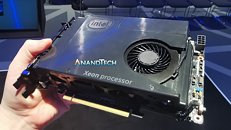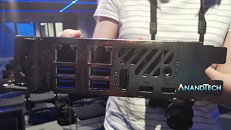Tuesday, October 8th 2019

Intel Readies "The Element" - a Next-Generation of Modular PCs
Yesterday Intel hosted an event in London, where it held a presentation and demonstration of new concept product. Simply called "The Element", this new products tries to introduce the concept of modular computing, where you can basically swap out parts and replace them with ease, to users of PCs who wanted this to happen for a long time.
If anyone remembers Razer's project Christine, which unfortunately didn't take off, this product should be of no surprise to them. The Element is a complete PC consisting out of CPU, RAM and Storage, with a PCIe slot attached to it. Featuring plenty of IO options like Thunderbolt, HDMI, Ethernet, USB, and Wi-Fi, The Element is a complete solution for computing. For the demo Intel soldered a BGA Xeon CPU with room for two SODIMM slots for memory and two M.2 ports for storage expansion, all cooled by a blower fan directly cooling the CPU heatsink. Power is supplied from PCIe slot (75 Watts) and 8 pin connector which would come from a regular PSU. There is also an option for the card to be powered by a 19 V power source if external power brick is provided.As you can see from the above images, this concept basically wants to put all the computing power on a card that attaches to the single motherboard with a PCIe slot. Such approach would allow for some interesting solution when it comes to the design of a system, where you could build anything from small form factor PCs all the way to the giant builds that feature dozen or so of these units in order to form a server like unit. Possibilities for configuring the system based on "The Element" are almost endless.
While this comes as a PCIe card, there would be no regular AIB partners to release their own PCB design. Instead AIB partners would just be allowed to make small aesthetics adjustments like different cooling type (watercooling anyone?) and different designs of backplates.While in the development phase for now, this concept is planned for release sometime in Q1 2020, most likely availability will be at the end of Q1 or beginning of Q2. Pricing is still unknown and configurations of this product will be OEM dependant, so that still remains a mystery until further notice.
Source:
AnandTech
If anyone remembers Razer's project Christine, which unfortunately didn't take off, this product should be of no surprise to them. The Element is a complete PC consisting out of CPU, RAM and Storage, with a PCIe slot attached to it. Featuring plenty of IO options like Thunderbolt, HDMI, Ethernet, USB, and Wi-Fi, The Element is a complete solution for computing. For the demo Intel soldered a BGA Xeon CPU with room for two SODIMM slots for memory and two M.2 ports for storage expansion, all cooled by a blower fan directly cooling the CPU heatsink. Power is supplied from PCIe slot (75 Watts) and 8 pin connector which would come from a regular PSU. There is also an option for the card to be powered by a 19 V power source if external power brick is provided.As you can see from the above images, this concept basically wants to put all the computing power on a card that attaches to the single motherboard with a PCIe slot. Such approach would allow for some interesting solution when it comes to the design of a system, where you could build anything from small form factor PCs all the way to the giant builds that feature dozen or so of these units in order to form a server like unit. Possibilities for configuring the system based on "The Element" are almost endless.
While this comes as a PCIe card, there would be no regular AIB partners to release their own PCB design. Instead AIB partners would just be allowed to make small aesthetics adjustments like different cooling type (watercooling anyone?) and different designs of backplates.While in the development phase for now, this concept is planned for release sometime in Q1 2020, most likely availability will be at the end of Q1 or beginning of Q2. Pricing is still unknown and configurations of this product will be OEM dependant, so that still remains a mystery until further notice.



41 Comments on Intel Readies "The Element" - a Next-Generation of Modular PCs
I don't understand why there so much resistance in comments. :-DThe prototype compute unit had an 8-pin connector and - in case you haven't noticed - a decent blower cooler is perfectly capable of taking care of 250W GPU.
It's just a question of noise.
IMO the blower cooler in Titan Xp would be fine for people used to Intel stock CPU fan, but that's about it.
That blower looks...pathetic.
Let's also not forget that this kind of setup drastically increases real estate cost in turns of PCB. You not only still need a motherboard to connect the PCI Express to power but also to connect all of the components to each other. Things like M.2 and SATA would be right on the motherboard so for most use cases, doesn't require an AIB.
Oh, and installing two of these modules into one system is a big "hell no" because the duplication of features and horrendously slow PCI Express being used for CPU-to-CPU communication will force the use of many NUMA domains to prohibit them from choking the PCI Express lanes. Oh, and in that case, forget installing any peripherals because the two CPUs need all x16 lanes to communicate.
I just don't see how this ends well. It's sacrifice after sacrifice after sacrifice and where's the big benefit offsetting all those sacrifices?
But most things are wireless anyway.
Is it more mess than how many gaming desks look? Keyboard and mouse usually on cords. Transparent cases standing next to monitors...
The point really is that it sounds like each of theses cards are fully contained system with its own CPU, memory, and storage. I would expect it to behave as such with the "PCIe" slot just really being for management, not for CPU-to-CPU communication.
4 x USB3 ports
1 x HDMI (obvious silicon wasted on IGP)
2 x Thunderbolt ports (USB-C connectors)
1 x L/R out/optical (has audio chip)
2 x RJ45 LAN connections (maybe some logic to this but if it's just hosting VMs and only has like 250w worth of performance, can it really saturate more than one NIC before the CPU gets overburdened?)
On top of that, a huge advantage of VMs is that you can increase and decrease hardware resources according to the demands of the clients (e.g. shift RAM/cores). Can't do that with this.Indeed, they're like NUCs in PCIe form factor...but why? I still don't see the point. Who is the target market?
Let me put it this way, if you're scaled up to 10 or 20 VMs, changing the characteristics of all those VMs is far more complicated than just spinning up another 10 VMs. Cloud resources cost money, so scaling quickly and effectively is very important, otherwise you're just wasting money.
I finally came up with a reason for these things (sort of): redundancy. That's still a problem with I/O though because there isn't a means to seamlessly roll over between units.
You don't upgrade it. You buy a new one. 100% correct. Even RAM may turn out to be soldered.
And yes, it's a perfect consumer product. Just not for you.Both correct and irrelevant. :)
PC users have wrong idea about case airflow. Most think that more airflow means better cooling.
It doesn't matter how much air gets through your case. It only matters how much is pushed through and near the radiators.
As such, most of airflow in typical ATX case is totally wasted. Air exiting the case is often just few K over room temperature.
It's very different in servers and laptops, where cooling potential is used as much as possible.
Air exiting most laptops is very hot - it can even get slightly unpleasant if vents are placed badly. But that also means it took A LOT of heat with it.
A cramped space with properly modeled airflow and properly placed radiators will be very efficient compared to what most PCs can achieve.
The only real issue here is noise. They'll have to provide something better than what Nvidia puts in Titan and pro cards.
Extra I/O never hurts, plus there isn't that much of it: just a dual-LAN, some USBs and HDMI (which is a big plus, if you need to hook it up to KVM console or switch).2xSODIMM slots, 2xNVME slots. The only non-upgradeable thing is CPU.If you are thinking that PCIe slot is some magic interconnect to the magic backbone, then it might be very disappointing consumer product. I'm 66.6% sure that they use the same approach as QNAP (e.g. Ethernet PHY backwards).
The only other way is wiring an actual PCIe x16, but then the backbone/motherboard basically becomes a glorified PCIe riser.
If this idea gets any traction, it'll likely follow the laptop route. Some modules will offer this kind of upgrading and some won't.The QNAP thing is a system on a card (coprocessor or not - as noted earlier).
This isn't what we're talking about.
"The Element" is just a NUC with a PCIe output.
The idea is not to buy 4 of these and build a cluster. It's about putting this next to other components connected via the PCIe base. It should be compatible with the stuff we have now (GPUs, PCIe drives etc).
And since you're getting rid of normal ATX motherboard (parallel to PCIe slots, forcing a lot of free space inside a case), the whole system becomes smaller.
A basic gaming configuration could consist of this module, a short GPU and a power supply.
This means that suddenly a "standard" PC is the size of a DAN A4.Exactly. That's what it's supposed to be. I've already used the word "riser".